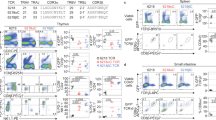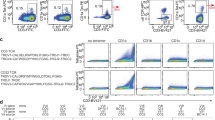Abstract
T-CELL antigen receptors (TCR) generally interact with moderate affinity with the complex formed by major histocompatibility complex (MHC) molecules and foreign peptides1–7. MHC/TCR recognition is followed by the generation of a signal to the T cell through a monomorphic multicomponent system that includes the CD3 complex and accessory molecules such as CD4 and CD8. The interaction between the extracellular domains of MHC and TCR molecules1–7, and the interaction of MHC and CD4/CD8 molecules8–10, have been considered to occur indepen-dently of one another. We report here that the affinity of CD8 dimers for MHC class I molecules is independent of haplotype and peptide content, and that the affinity of the TCR for its specific ligand is enhanced through a reduced 'off" rate in the presence of either CD8αα homo- or CD8αβ heterodimers. More-over, CD8 seems to help recognition of the specific MHC–peptide complex either by guiding an energetically favourable docking of TCR onto MHC, or by inducing conformational changes in the MHC complex that can augment the TCR/MHC–peptide inter-action. CD8 should therefore be considered as an active partici-pant in the T-cell recognition complex, rather than simply as an accessory molecule.
This is a preview of subscription content, access via your institution
Access options
Subscribe to this journal
Receive 51 print issues and online access
$199.00 per year
only $3.90 per issue
Buy this article
- Purchase on Springer Link
- Instant access to full article PDF
Prices may be subject to local taxes which are calculated during checkout
Similar content being viewed by others
References
Matsui, K. et al. Science 254, 1788–1791 (1991).
Weber, S., Traunecker, A., Oliveri, F., Gerhard, W. & Karjalainen, K. Nature 356, 793–795 (1992).
Corr, M. et al. Science 265, 946–949 (1994).
Matsui, K., Boniface, J. J., Steffner, P., Reay, P. A. & Davis, M. M. Proc. Natl Acad. Sci. USA 91, 12862–12866 (1994).
Sykulev, Y. et al. Immunity 1, 15–22 (1994).
Scott, C. A., Garcia, K. C., Carbone, F. R., Wilson, I. A. & Teyton, L. J. Exp. Med. 183, 2087–2095 (1996).
Sykulev, Y. et al. Proc. Natl Acad. Sci. USA 91, 11487–11491 (1994).
Doyle, C. & Strominger, J. L. Nature 330, 256–259 (1987).
Potter, T. A., Rajan, T. V., Dick, R. F. & Bluestone, J. A. Nature 337, 73–75 (1989).
Salter, R. D. et al. Nature 345, 41–46 (1990).
Matsumura, M., Saito, Y., Jackson, M. R., Song, E. S. & Peterson, P. A. J. Biol. Chem. 267, 23589–23595 (1992).
Van der Merve, P. A., Brown, M. H., Davis, S. J. & Barclay, A. N. EMBO J. 12, 4945–4954 (1993).
Udaka, K., Tsomides, T. J. & Eisen, H. N. Cell 69, 989–998 (1992).
Udaka, K., Tsomides, T. J., Walden, P., Fukusen, N. & Eisen, H. N. Proc. Natl Acad. Sci. USA 90, 11271–11276 (1993).
O'Rourke, A. M., Rogers, J. & Mescher, M. F. Nature 346, 187–189 (1990).
Luescher, I. F. et al. Nature 373, 353–356 (1995).
Rojo, J. M., Saizawa, K. & Janeway, C. A. Jr Proc. Natl Acad. Sci. USA 86, 3311–3315 (1989).
Gallagher, P. F., Fazekas de St Groth, B. & Miller, J. F. A. P. Proc. Natl Acad. Sci. USA 86, 10044–10048 (1989).
Hoo, W. S. & Kranz, D. M. J. Immunol. 150, 4331–4337 (1993).
Vignali, D. A. A., Carson, R. T., Chang, B., Mittler, R. S. & Strominger, J. L. J. Exp. Med. 183, 2097–2108 (1996).
Stanfield, R. L., Takimoto-Kamimura, M., Rini, J. M., Profy, A. T. & Wilson, I. A. Structure 1, 83–93 (1993).
Tourvieille, B., Gorman, S. D., Field, S. H., Hunkapiller, T. & Barnes, J. R. Science 234, 610–614 (1986).
Kranz, D. M., Tonesgawa, S. & Eisen, H. N. Proc. Natl Acad. Sci. USA 81, 7922–7926 (1984).
Staerz, U. D. et al. J. Immunol. 134, 3994–4000 (1985).
Becker, M. L. B. et al. Cell 58, 911–921 (1989).
Ajitkumar, P. et al. Cell 58, 911–921 (1989).
Author information
Authors and Affiliations
Rights and permissions
About this article
Cite this article
Garcia, K., Scott, C., Brunmark, A. et al. CD8 enhances formation of stable T-cell receptor/MHC class I molecule complexes. Nature 384, 577–581 (1996). https://doi.org/10.1038/384577a0
Received:
Accepted:
Issue Date:
DOI: https://doi.org/10.1038/384577a0
This article is cited by
-
Haplotype structures and polymorphisms of dog leukocyte antigen (DLA) class I loci shaped by intralocus and interlocus recombination events
Immunogenetics (2022)
-
Affinity-matured HLA class II dimers for robust staining of antigen-specific CD4+ T cells
Nature Biotechnology (2021)
-
Epigenetic plasticity of Cd8a locus during CD8+ T-cell development and effector differentiation and reprogramming
Nature Communications (2014)
-
CD8αα and ‐αβ isotypes are equally recruited to the immunological synapse through their ability to bind to MHC class I
EMBO reports (2011)
-
An endogenous positively selecting peptide enhances mature T cell responses and becomes an autoantigen in the absence of microRNA miR-181a
Nature Immunology (2009)
Comments
By submitting a comment you agree to abide by our Terms and Community Guidelines. If you find something abusive or that does not comply with our terms or guidelines please flag it as inappropriate.



